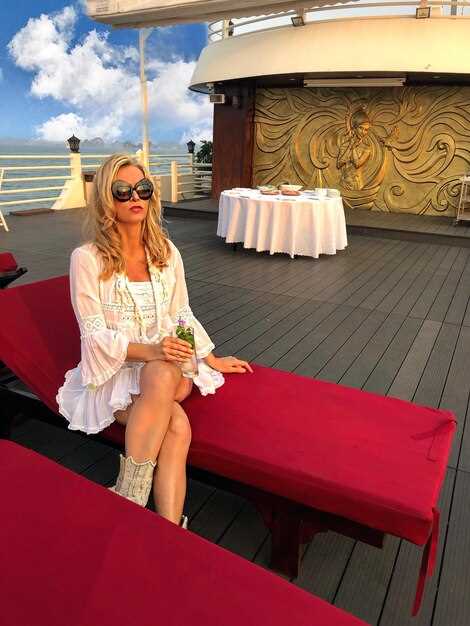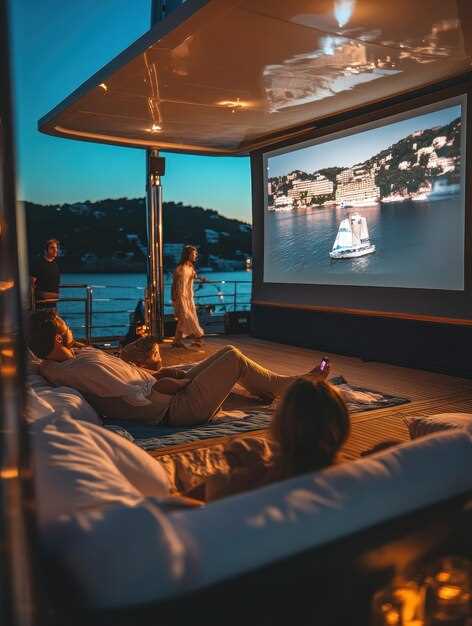Book a private IMAX session on the Lady S now to enjoy an on-deck cinema, which anchors cruising days with immersive visuals and precise sound.
The theater blends a technological list of innovations to deliver screen-quality that travels with the yacht, a hallmark of superyachts experiences. It includes a floor-to-ceiling, edge-to-edge screen, featuring a refined color science, modular seating, and an audio system that responds to ship motion. An elevator ferries guests from the foyer to the screening hall, while private access paths lead to balconies with multiple sightlines. The staff include technicians who tailor each screening, including ipod-linked playlists and kid-friendly toys, so the experience suits families and couples alike.
During itineraries that feature snorkeling, fishing, or twilight cruising, the IMAX program adapts with content that complements the day. The curation list blends nature documentaries with action titles, often paired with short pre-shows that explain the ship’s goals for the voyage. The design uses dampers to leach vibration away from the seating, preserving clarity even when the hull hums. Private pits offer intimate viewing for guests who want a more secluded vibe, while still enjoying the skyline and sea spray from the balconies.
Keep the experience seamless by syncing your preferences on the private yacht app, or request a tailored program from the crew, who manage everything from lighting cues to in-room ipod control. When cruising, you can plan a theater session that starts after a gourmet lunch on deck, with the elevator ride signaling the transition to cinema and the world outside shrinking to the horizon through the large screen.
IMAX Cinema on Lady S: Practical Specifications and Operational Considerations
Recommended setup: install dual 4K laser IMAX projectors paired with an 8.5 m wide screen (28 ft) and 3.7 m high image in a dedicated, acoustically treated theater. This configuration ensures a crystal-clear, unparalleled viewing experience on the floating Lady S during cruising, with brightness up to 1,200 nits, native 2.39:1 aspect, and a million-color palette. A 12.1-channel audio array delivers immersive sound, while HDMI 2.1, HDR10 and Dolby Vision sources are supported from the onboard library, streaming, or external cinema feeds.
Designed by timchenkos and michael, the theater integrates with the hammam and private spa area on the upper deck. An elevator provides private access from the spa to the screening room, maintaining flow for guests on vacation. The seating array of 28 premium recliners sits on a gentle incline for perfect sightlines, and crystal panels along the walls reduce reflections while the ambient LED array can match the scene’s color temperature. A private viewing lounge offers an intimate space for those who want to linger after the credits, and a terrace near the helipad delivers sunset pre-shows with ocean views.
Operational considerations include stability, power, and safety. Active vibration isolation keeps the image steady in cruising conditions; a marine-rated anti-vibration system mitigates movement during swell. The cinema runs on a dedicated 480V three-phase supply with a typical load of 60–90 kW and peak demand near 100 kW during screenings; a seawater-cooled chiller maintains 22–24°C with N+1 redundancy. Fire suppression, smoke detection, and maritime egress standards are integrated, and all gear sits behind soundproof doors to protect guest comfort. The control network ties into Lady S’s management system for remote monitoring and failover. источник
Maintenance and operations cover scheduling, content management, and crew training. Daily color calibration and brightness checks preserve uniform image quality across the screen; laser modules typically deliver 20,000–30,000 hours and are serviced during planned dry-dock windows. A private library supports curated screenings for those on summer voyages, while the crew coordinates with the pools, hammam, and private lounges to synchronize ambience and service. For those seeking a perfect vacation experience, sunset and ocean-view reels can be programmed to accompany cocktail hours on deck.
Practical optimization tips: schedule screenings in low ambient light, use blackout curtains, and select HDR content to maximize crystal clarity. Keep the hammam and spa areas quiet during setup to minimize vibrations, and align with the entertainment array to ensure seamless transitions between spaces. Provide private screening options for those on private tours and offer a tailored menu to match film genres, creating an array of moments that epitomize luxury cruising and private indulgence. This approach highlights how a curated IMAX experience on a luxury floating vessel can deliver much more than cinema–it becomes a centerpiece of a million-bedroom vacation atmosphere, with highlights that elevate views, comfort, and privacy for every guest.
Room Design and Seating Layout for Optimal IMAX Experience at Sea
Install a curved IMAX-grade screen about 2.3–2.5 m wide on the main lounge wall and configure seating with slide seats that fold-out to switch between 8 and 14 seats. This delivers optimal sightlines for every guest, whether cruising for a week or hosting evenings with family, ensuring a world-class viewing experience to make evenings at sea memorable.
Layout features a three-tier arc around the theater: front row fold-out seats closest to the screen, a mid-row of fixed but comfortable sofas, and a rear row on an adjustable platform to maximize legroom. The arrangement slides along rails to reconfigure in seconds for premieres or private screenings. Use premium leather or microfiber in charcoal tones to minimize glare and keep the picture crisp, with the featuring modular units designed to have details that survive long voyages.
The room features a treated, low-resonance ceiling and walls with diffusers; a 5.1 or 7.1 system featuring in-ceiling speakers and a discreet subwoofer bank delivers immersive sound without vibration at sea. Lighting automatically dims to cinematic levels during shows, and blackout curtains control reflections on bright days. The materials chosen prioritize luxury and durability, making performance predictable in varying weather conditions.
Space planning and flow place the theater near dining and spa zones such as hammam, enabling easy transitions between meals, rituals, and cinema. Ensure acoustical doors seal when closed and that the elevator connects the deck levels for accessibility. Even when the helikopterplatta is active, isolation from exterior noise keeps cinema quiet and comfortable.
Operational details and expenses: The seating uses modular components with low maintenance cycles; fold-out units and slide rails are integrated into a single cabinetry structure, reducing installation complexity. The configuration supports multiple uses during a week-long charter on superyachts, delivering premium, flexible cinema capability. The project was led by designer Michael, and the team paid attention to details such as wiring, ventilation, and power loads to ensure quiet operation when the yacht is underway.
Accessibility and user experience: Provide an elevator to the theater level and reserve rows for wheelchair access with companion seating. Include a simple control panel for crew to manage screening playlists, lighting, and temperature. Please tailor this space to match the destination where guests gather for evenings after dining on deck, so life aboard on luxury Yachter feels effortlessly refined.
Screen Technology, Size, Resolution, and Brightness in a Maritime Environment

Invest in a modular 4K HDR LED system with anti-reflective glass and 1000–1200 nits brightness for daylight readability, and configure panels to reframe for gatherings across onboard theaters and suites while traveling.
Main theater screens should range 90–110 inches, delivering 4K resolution, 10‑bit color, and HDR10+ or Dolby Vision; add 65–75 inch panels in suites to offer tailored experiences for smaller groups, and use a modular video wall to expand coverage for many guests across rooms.
Boast 4K with HDR and high color fidelity: aim for 4K at 60 Hz (or 120 Hz for motion) with 10‑bit color and HDR, and calibrate for crystal blues and whites; provide detailed skin tones and ocean textures for authentic viewing.
Aim for peak brightness around 1000–1200 nits in bright climate spaces, and let brightness auto‑adjust with ambient sensors; use local dimming to preserve deep blacks while maintaining highlight detail even when the cabin is filled with sunlight.
Salt can leach into electronics if seals fail; anti glare coatings and water‑repellent seals keep components safe; protect external modules with IP65+ housings and ensure sealed cooling to handle humidity and salt spray in marine environments.
Vibration‑aware mounting supports chic lounges and dining areas; rugged, damped supports protect the main screen while the captain surveys the horizon; use a 2×2 video wall in larger spaces among salons and suites to tailor the mood.
Efficient LED backlighting lowers fuel use, while redundant power rails and an uninterruptible supply keep shows running during rough seas; the crew is always aware of energy use and optimizes settings for traveling itineraries; schedule maintenance to align with routine port calls.
gennady, the lead engineer, oversees calibration and maintenance, ensuring color accuracy stays consistent across theaters, dining rooms, and suites; keep a details log of gamma, white point, and color calibration steps for quick audits.
Outdoor zones near the coast tolerate sunlight with weather‑proof housings; snorkeling and paddleboards unlock deck activities, and the system can be tuned to switch to daytime mode for deck gatherings before sunset so guests enjoy the panorama in chic comfort.
Acoustic Engineering: Sound Isolation and Immersive Audio on a Moving Vessel
Recommendation: Implement a decoupled floating floor and independent ceiling designed to isolate the theater from hull motion, with dense partitions and sealed joints. This investment yields calm, true listening during voyages across those destinations in the Mediterranean, especially in summer evenings. Fold-out panels keep equipment hidden when not in use, and a captain-friendly control set preserves light and atmosphere for every seating, enabling much more than a casual background track.
Three core layers form the heart of the system: a mass-rich wall assembly with constrained-layer damping; decoupled subfloor and ceiling to divert hull motion; and sealed interior boundaries to prevent airborne leakage. The hull pits are used to absorb low-frequency energy, while timchenko-inspired calibration aligns the DSP to compensate for roll and pitch, preserving a stable array of sound that keeps the audience centered on the theater’s image even during swift accelerations. This arrangement supports those evenings and voyages with consistent clarity across the Mediterranean.
Audio design detail: The speaker array uses a 7.1 or 9.1 layout with behind-screen subs, chosen for the vessel’s geometry. The system is supplied with marine-grade amplification and a world-class DSP chain; an ipod input gives guests quick control from seat to play personal playlists. The theater is equipped with fold-out seating and subtle light management to keep distraction minimal. DSP-driven equalization balances reflections to deliver clarity, sophistication, and immersion for those experiences.
Operational guidance: The captain can adjust levels during departures from ports, ensuring a quiet ambience during arrivals at destinations. For voyages, the system should plunge from dialogue to immersive sound seamlessly, and the control interface should support evenings settings. The investment in light-weight, marine-grade materials yields a robust, Mediterranean-friendly performance, with fuel budgets kept in check by efficient amplification and cooling.
| Area | Isolation (dB) | Immersion/Notes | Equipment/Implementation |
|---|---|---|---|
| Floor/Plinth | 25–35 | Decoupled plinth preserves bass while keeping cabin quiet | Floating floor, visco dampers |
| Walls/Partitions | 35–50 | Constrained-layer damping provides silhouette isolation | Mass-loaded vinyl, double-stud frame |
| Ceiling | 20–40 | Minimized reflections; even vertical coverage | Acoustic coffers, resilient channels |
| Speaker Array | N/A | 7.1/9.1 with DSP correction; stable imaging | Line array, marine-grade cabinets |
Power, HVAC, and Onboard Infrastructure to Support IMAX Systems

Install a dedicated, redundant power feed and a precise HVAC loop designed for IMAX cinema, with a 400V three-phase supply, UPS, and a stand-by generator sized to meet peak projector loads. Many owners on a superyacht seek a backbone that prevents brightness fluctuations and thermal drift, ensuring consistent, cinema-grade experiences featuring blockbuster titles for guests across suites, dining areas, and entertainment lounges.
Power distribution should center on a master electrical panel with dedicated busbars, isolation transformers, and harmonic filters, plus power quality monitoring and remote diagnostics to keep expenses predictable and maintenance focused on the IMAX load.
HVAC specifics include a closed-loop chilled-water plant or seawater-cooled circuit feeding cinema rooms and equipment rooms, with separate air handling units, vibration isolation mounts, low-noise fans, and high-efficiency filtration. Maintain temperature to tight tolerances and provide rapid recovery after screenings to keep projector optics stable.
Onboard infrastructure includes a master control room, a dedicated fiber backbone, and a cinema rack that is physically isolated from crew corridors. The deck plan allocates a space near the helipad for equipment switchover and a locker for paddleboards, signaling that the globe-spanning experience can be enjoyed without interfering with day-to-day operations. The layout supports many configurations–from intimate signature suites to most expansive dining salons–allowing guests to enjoy a dynamic theater while vacationing afloat.
Such tailored configurations make IMAX on a superyacht not only a master class in entertainment but the epitome of luxury experiences. Featuring a range of content, the system pairs gourmet dining with immersive visuals that go beyond the screen. Guests can enjoy many global titles while sipping premium wines in suites overlooking panoramic windows, from the globe to the gourmet dining salons, and always returning to their vacation with memories that linger. This arrangement makes the onboard cinema the epitome of luxury on the sea.
Content Delivery, Licensing, Scheduling, and Crew Training for Yacht Cinemas
Adopt a centralized content delivery protocol that synchronizes licensing, scheduling, and crew training across all yacht cinema operations.
- Content Delivery and Technology
- Maintain a high-security on-board server with offline caching of approved titles, ensuring high-quality playback even when signal quality fluctuates across the globe, from the mediterranean coast to remote anchorages.
- Use a technological stack that supports 4K HDR, Dolby Vision/Atmos where available, and quick metadata searches to simplify guest selection.
- Establish a workflow for content ingestion, verification, and license renewals via the legal team; track licenses in a centralized ledger to prevent breaches and to support tenders for new acquisitions. theres a practical cadence for updates and audits.
- Set up a redundant distribution path between the ship’s server, a secure maritime satellite link, and a shore-based control room to handle urgent changes on a private schedule.
- Licensing and Legal Compliance
- Build a license matrix by region, including mediterranean itineraries, to ensure lawful playback on board private superyachts and during globe-trotting cruises; theres direct coordination with studios and distributors.
- Maintain a transparent list of authorized titles with expiry dates, usage rights, and geographic restrictions; include leach as the legal advisor for content audits when needed.
- Draft clear agreements with content partners and a feadship involvement to align with the yacht’s listing and charter schedule; ensure consent for on-board showings during tenders and port calls.
- Implement age-rating controls, accessibility features, and privacy safeguards to respect guests’ preferences and family safety norms, especially for younger audiences during snorkeling days and beach visits.
- Scheduling and Content Calendar
- Create a rolling 8–12 week calendar that matches voyage plans, port calls, and tender schedules; prioritize titles that suit the mood of a family gathering, a private screening for billionaire owners, or a casual evening for their family on deck.
- Coordinate with itineraries to avoid conflicts with activities such as snorkeling, paddleboards, or tender departures, and reserve peak-busy slots for high-impact screenings.
- Link programming to local culture and routes, for example mediterranean coast experiences or feadship-built ships’ home ports, to enhance guest immersion.
- Maintain a quick-access list of most-wanted titles for the captain and crew so they can swap titles in response to weather, seas, or last-minute guest requests.
- Crew Training and Operational Readiness
- Deliver tailored training modules for cinema techs, boat crew, and guest services to ensure flawless operation from boarding to debrief; include emergency procedures and cinema-space safety checks.
- Train crew on content menu navigation, parental controls, and guest etiquette, so family groups feel welcomed and confident in selecting films during extended voyages.
- Institute a cross-functional SOP that covers equipment checks, room setup, sanitation, and bathroom provisions, while keeping comfort and guest experience in mind.
- Use regular drills and checklists; assign responsibilities to a tech lead, a deck liaison, and a guest-relations host to maintain smooth execution across high-capacity screenings.
- Incorporate feedback from private sailing teams including timchenko-backed charters and other owners to refine service quality and ensure the program stays technologically-forward and customer-first.
- Maintain a library of on-board training materials and quick-reference guides for sea and port calls; update the content as new titles arrive and licenses renew.
- Whilst training, address kid-friendly experiences by guiding crew on handling toys and interactive guest devices to keep young guests engaged safely.

 IMAX Movie Theaters Aboard the Luxury Superyacht Lady S – Redefining Onboard Cinema for Yachts">
IMAX Movie Theaters Aboard the Luxury Superyacht Lady S – Redefining Onboard Cinema for Yachts">